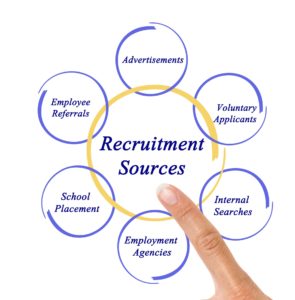Jen Chelini | March 24, 2022

What are the actions in your plan when no one seems to be applying? All successful recruiting strategies have one critical element among them – they all have a plan.

Introduction
All successful recruiting strategies have one critical element among them – they all have a plan. At Leap Solutions, we customize a plan for every recruitment. It would be simple to post an opportunity and then sit back and wait for all the applicants to flow in…. but we all know in this job market that will not lead to success.
What are the actions in your plan when no one seems to be applying, applicants are non-responsive, candidates are reevaluating work/life balance, and others are voicing concerns about returning to an unknown future?

Recruiting Strategies
Here are a few basic steps to structure the components of your plan:
- Treat candidates like customers by nurturing them.
- Improve the candidate experience through proactive communication from start to finish.
- Take time to brand your company. This is an excellent passive recruitment sourcing strategy. Use social media – Facebook, LinkedIn, Instagram, Twitter – to post positions and engage with candidates. Passive recruitment targets potential candidates who aren’t necessarily looking for a new role, but become enticed to apply based on your company website and social media branding.
- Implement an employee referral program. Employee referrals can reduce your time to hire, improve your quality of hire and increase your retention rate.
- Engage passive candidates. These are candidates who aren’t necessarily looking but can be found without posting traditional ads.
- Include past applicants and past employees as potential candidates. Use the talent pipeline you worked hard to build the first time around.
Create compelling job postings.
a. Showcase dynamic summaries that get candidates excited about the role.
b. Ask and answer – “How does the position fit into the organization?”
c. Highlight your values and culture, which can be your most important asset.
d. Design jobs with realistic requirements
e. Touch on succession and/or career development opportunities – topics at the top of a candidate’s list when looking
for a new role.
- Source via hiring events including in-person and online events; job fairs, venue rentals, and virtual events. Don’t forget to advertise these events via posting ads, newsletters, and your website.
- Source laid-off workers. It’s important to gain an understanding of why these workers are hesitant about the future. Today’s candidates are focused on work/life balance, offering flexible working conditions, mental wellness, and desire transparency when it comes to potential salaries.
- Focus on financial and physical wellness, and company culture, offer honesty and transparency throughout the hiring process. Candidates often turn down offers based on the company culture. They might initially take the offer, but continue to search for new opportunities.

Are You Ready to Leap?
***
Leap Solutions is a diverse group of highly skilled management professionals serving our clients with their organizational development, human resources, and executive search and recruitment needs. We have spent decades doing what we feel passionate about helping you feel passionate about what you do. With the ever-changing COVID-19 response, our HR specialists can help you get a handle on the guidelines, programs, and legislation that may impact you and your employees. Through all of our services, we are available to work with you to develop practical solutions and smart planning decisions for your organization’s immediate, near, and long-term needs.
To print this article, Click Here


Tracy Long | February 25, 2022
Employees want and need feedback. Regular feedback, when done proportionately with recognition and development discussions, can build relationships, establish trust, and improve performance.
In this issue of our newsletter
-
- Introduction
- Recognition Feedback
- Developmental Feedback
- Feedback in a Remote World

Introduction
For the recipient, feedback can often be associated with criticism providing a negative connotation to the experience. No matter how you dress it up, no one wants to be criticized. More importantly, does criticism lead to improved performance? It might in the short term, but it erodes your relationship with an employee if not handled well. No wonder so many managers would rather ignore the behavior and hope it goes away rather than risk making things worse by talking with the employee.
Employees want and need feedback. It should be regular, and it should focus on what the employee is doing well and provide opportunities for improvement. Regular feedback builds relationships and establishes trust. Building trust allows the employee to accept the developmental feedback, especially if they feel you have their best interest at heart.
In the absence of feedback, employees fill in the blanks. Generally, employees think that they are doing a great job, which can be reflected in their self-appraisal. It often comes as a surprise, when during the annual appraisal meeting, the employee learns that they are not meeting expectations or need improvement in some area. If the feedback occurred prior to the review and with frequency, the discussion can focus on improving future performance rather than hashing out past performance which feels like criticism.
Many managers want to be able to talk with their employees, but they just don’t know-how. This struggle to give feedback is likely rooted in fear; fear that they will say it wrong; fear that they can’t effectively handle feedback resistance; fear that the person might retaliate or gossip to others in the work community. After all, managers are people too! So, where do we start? For purposes of this discussion, we will be referring to feedback as recognizing someone’s achievements (recognition) and improving their performance (development).

Recognition Feedback
When providing feedback, it is easy to examine what is not going well and start there. However, if all you can find is fault, it will be much harder for the employee to trust that you have their best interest at heart and even harder for them to want to change their behavior. Instead, look at what the employee is doing right and tell them. If they hear more recognition feedback than developmental feedback, they will more easily accept the developmental feedback. When an employee sees that you notice their positive behavior, it’s more likely that they will repeat those behaviors. The more positive behaviors you notice, the more likely the employee will strive for continual improvement.
Recognition feedback tips:
- Do it often. Regular conversations with employees about their performance strengthens your relationship and builds trust.
- Don’t be in a hurry when providing positive feedback. Give the person your full attention when you engage with them.

Developmental Feedback
The intent of developmental feedback is to correct the behavior, not to punish the employee. The less defensive someone feels, the more likely they will hear what you are saying and make the necessary change.
When giving developmental feedback, it should be:
- Timely
- Specific (use facts, not gossip or innuendo)
- The discussion centers around the needed behavior changes, not around the person (or their personality traits)
To help you with this conversation, a feedback model such as Situation, Behavior, Impact, Future (SBIF) can help you set the stage.
Situation – Explain what the situation is that is causing the need for the discussion so that the context is clear.
Behavior – Specify the behavior that is causing or contributing to the situation.
Impact – Describe the impact the behavior has on the customer, client, team, department, organization.
Future – Discuss what behaviors should occur to avoid this situation in the future. You may offer suggestions, but it’s best to ask the employee for their thoughts first so that they can own the solution.

An Example Using the SBIF Model
This model can help you develop a conversation that is clear, non-judgmental, and empower the employee to take responsibility for their own development. Here is an example using the model.
Hi John
S – Everyone is expected to be at work on time every day so that we can meet our customer’s expectations of quality and on-time delivery. Yesterday, we really had to scramble to get our load out on time.
B – This was the day that you arrived to work 30 minutes late. This is the third time this month that you have been late, and I am concerned a pattern is developing.
I – When you arrive late, we have to rearrange the workload to cover for you and the team has to work faster to ensure that the loads leave on time. This places a burden on your teammates and can lead to morale issues when a pattern develops. It can also lead to a decrease in quality (loading mistakes increase) which causes customer dissatisfaction. Again, we all count on the team to accomplish our commitments to our customers.
F – Going forward, what are your commitments to ensure that we are meeting our customer’s expectations and the team is supported?
The feedback revolves around the person’s behavior and the impacts on the customer commitments and team expectations. The language with the employee is “you” focused to ensure they understand the responsibility and accountability of their position. The employee is asked for a solution to their issue rather than a mandate from the manager. This allows the employee to discuss their contributing factors which could be important for understanding and resolving the issue. This is not about blame as it is about problem-solving and behavior resolution.

Feedback in a Remote World


With the number of employees working remotely, you might wonder if feedback is different in this environment. Out of sight can feel like out of mind for remote employees, and additional actions to engage them might take a little more effort. Frequent check-ins can help you keep a pulse on what is going on for them. It is hard to appreciate the day-to-day struggles and accomplishments in a remote environment so a variety of feedback channels should be considered. In addition to communication channels like email, Zoom and phone, a chat app like Google chat gives you the ability to send instant messages. Conversations through Yammer where teammates can build connections and share what’s going on with them or their department can be helpful for staying in touch. Various software tools including Microsoft Teams provide communication options. However, in addition to the many electronic tools available, use face-to-face meetings, which allow for the reading of body language, tone, and strong listening skills. Frequent check-ins can have an effect of feeling micro-managed so asking the employee for their preferred format and timing of feedback can help them distinguish between support versus micro-management.
Feedback, when done proportionately with recognition and development discussions, can build relationships, establish trust, and improve performance.
Make 2022 the year of Feedback!

Are You Ready to Leap?
***
Leap Solutions is a diverse group of highly skilled management professionals serving our clients with their organizational development, human resources, and executive search and recruitment needs. We have spent decades doing what we feel passionate about helping you feel passionate about what you do. With the ever-changing COVID-19 response, our HR specialists can help you get a handle on the guidelines, programs, and legislation that may impact you and your employees. Through all of our services, we are available to work with you to develop practical solutions and smart planning decisions for your organization’s immediate, near, and long-term needs.
To print this article, Click Here







![]()







